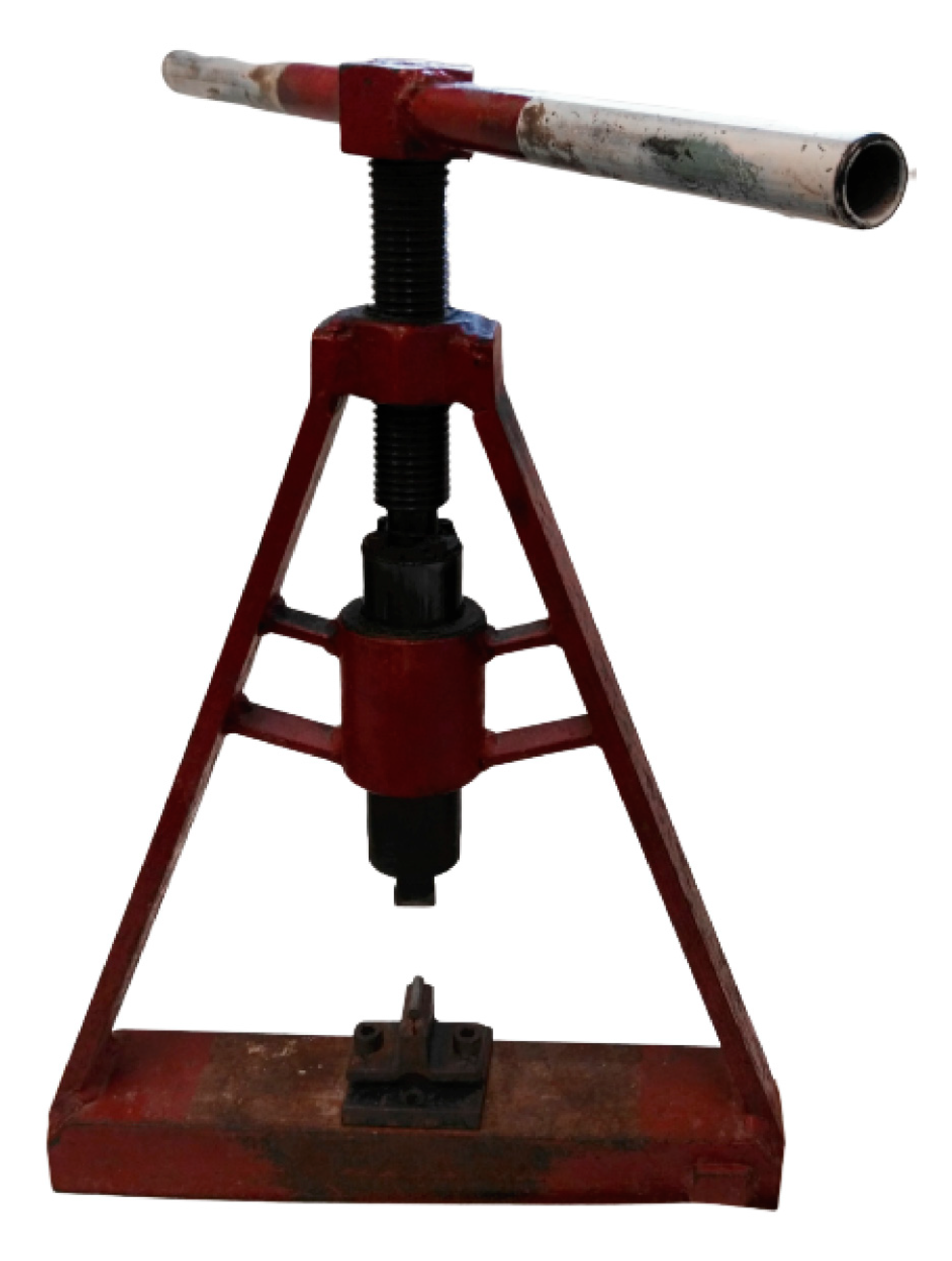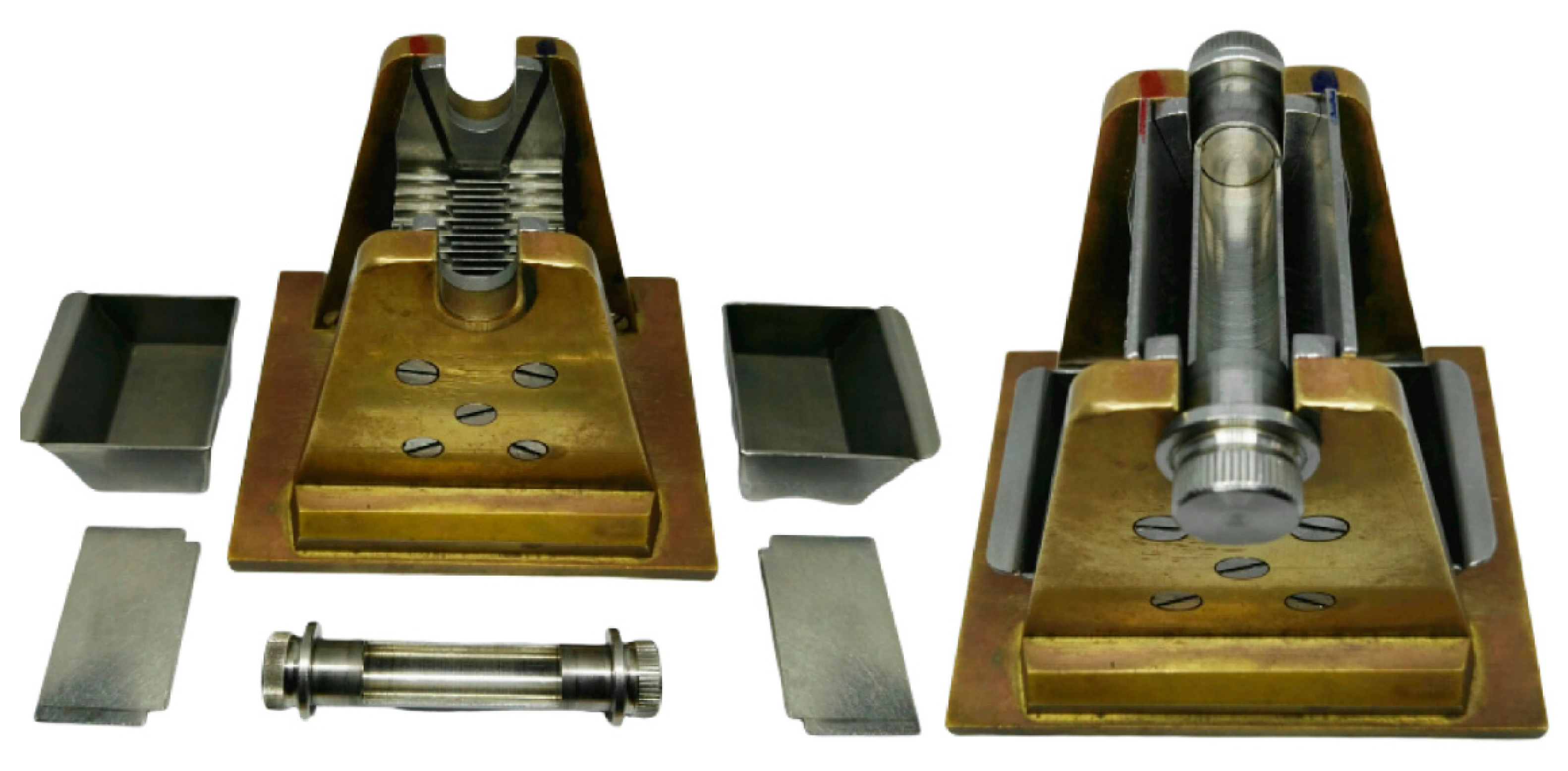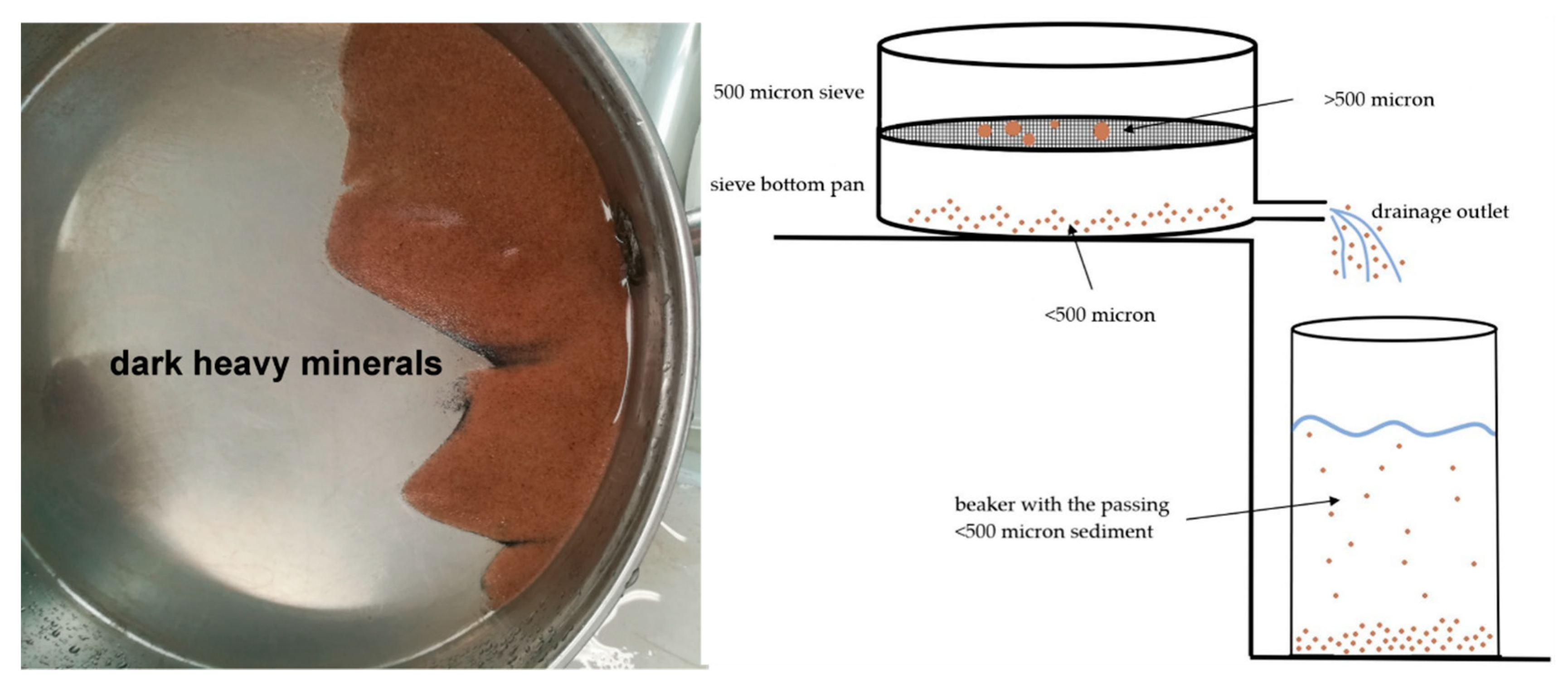Gravimetric Separation of Heavy Minerals in Sediments and Rocks
Abstract
:“Day by day, what you choose, what you think, and what you do is who you become”Heraclitus
1. Introduction
2. Sampling
3. Safety Rules and Pre-treatments
NB: Never ever use bromoform. This organic liquid is toxic and carcinogenic!
3.1. Preparation of Na-Polytungstate
3.2. Preparation of Na–Dithionite–Citrate–Bicarbonate
3.3. Preparation of Nylon Sieves with 5 μm and 15 μm Mesh
NB: Carefully wash the PVC ring with tap water to eliminate residues of abrasive grains used in sandpaper (e.g., moissanite but sometimes also garnet) that may contaminate the heavy-mineral fraction.
3.4. Sample Drying
4. Let Us Start!
4.1. Rock and Consolidated Samples
4.2. Micro-Sampling of Loose Sediment
4.3. How Much Do We Need?
NB: For modern sands, heavy-mineral concentration can be expeditiously assessed by weighing a well-filled plastic vial of known volume.
NB: Playing with examples:
Silt from a collision orogen unaffected by hydraulic sorting: t = 1, ρR = 2, S = 0.5, and H = 1→ X = 1g
Modern sand from granitoid rocks: t = 1, ρR = 6, S = 2, and H = 4→ X = 48g
Gravelly sand from a magmatic arc: t = 1, ρR = 2, S = 30, and H = 1→ X = 60g
Mesozoic fine-grained sandstone from a cratonic basement: t = 10, ρR = 10, S = 1, and H = 1→ X = 100g
4.4. Do We Really Need Large Samples for U-Pb Zircon Dating?
5. Sieving Procedures
NB: The worst mistakes that may occur in the lab are accidental sample switch or sample contamination. To stay on the safe side, samples are best processed in numerical order. In case of a modern fluvial system, you may proceed from upstream to downstream.
5.1. Wet Sieving with Steel Sieves
NB: During this process, dense minerals may concentrate and remain in the sieve bottom pan. The bias introduced by an inaccurate recovery from the beaker may be serious, especially for heavy-mineral poor samples and for the densest heavy minerals (Figure 4).
NB: Since we choose to avoid chemical attack with hydrogen peroxide, samples very rich in plant debris pose a problem; their mechanical comminution during sieving produces a flux of particles that pass through the steel meshes. The weight of the passing fraction is thus somewhat overestimated and the heavy-mineral concentration slightly underestimated. Repeated washing beyond 3–5 times is therefore not recommended.
NB: Sediment in suspension can be recovered from the beaker for further investigations of clay mineralogy and chemistry or organic matter.
5.2. Wet Sieving with Nylon Sieves
NB: A light pressure and continuous stirring are necessary to speed up the sieving process and avoid that the clay is deposited, thus clogging the meshes. Excess pressure, however, can break the nylon sieve.
NB: The use of ultrasonic bath is not recommended, as it might lead to the deformation of nylon meshes, thus jeopardizing the quality of the sieving process.
NB: While recovering sediment from the paper filter, be careful and avoid exerting an excessive pressure with your fingers that may generate paper fibers in the sample. In this event, the fibers can be easily removed with an electrostatically charged tip. Successively, whenever the sediment is poured on paper for weighing or splitting, the use of transparent paper is recommended to avoid undesired electrostatic effects and material loss which may be significant for silt samples and platy minerals.
5.3. Clay-rich Samples: Settling Tubes and Wet Sieving at 5 μm
6. Gravimetric Separation by Centrifugation
NB: The conic tubes must have externally printed graduation; otherwise, grains may be trapped by the internal graduation steps.
6.1. Ordinary Separation with SPT at 2.90 g/cm3
NB: Do note ever press the conic tubes in the holder of the centrifuge. Always use a balanced setting with tubes having the same weight to avoid undesired vibration leading to automatic blockage.
NB: Instead of liquid nitrogen, you may use a freezing mixture consisting of ice and salt at temperatures −11/−14 °C, although the procedure results to be laborious and time-consuming.Dry ice is also effective, cheaper, and easier to handle than liquid nitrogen. Freezing of SPT is achieved within ca. 5 min where a centrifuge tube is half-embedded in dry ice within an insulated, lidded container. A further advantage is the slow sublimation of dry ice; provided the container is insulated, 1 liter of dry ice will persist for at least 12 h at 18 °C and can be used repeatedly during a separation session.
NB: Do not touch the interior of the conic tube with the tip of the wash bottle to avoid picking up grains and preventing the contamination of successive samples.
6.2. Separation with Nontoxic SPT at 3.15 g/cm3
6.3. Recovery of Diluted SPT
7. Preparation of Grain Mounts
Canada Balsam
NB: The minimum quantity needed for the grain mount is 3–5 mg. It is wise to keep in the archive the remaining part of the heavy-mineral fraction for replicate analyses and future investigations.
NB: The heavy-mineral mount and the cover slip should be positioned in an asymmetric position, approximately in the middle of the left half of the slide. This enables using the entire area of the mount during point counting.
NB: The hot plate should be very slightly inclined toward the back of the fume hood to facilitate spreading the balsam and expelling all air bubbles.
8. Conclusions
Funding
Acknowledgments
Conflicts of Interest
References
- De Filippi, F. Sulla costituzione geologica della pianura e delle colline della Lombardia. Annu. Univers. Stat. 1839, 59, 225–248. [Google Scholar]
- Artini, E. Intorno alla composizione mineralogica delle sabbie del Ticino. Giornale di Mineralogia Cristallografia e Petrologia Pavia 1891, 2, 177–195. [Google Scholar]
- Garzanti, E.; Andò, S. Heavy Minerals for Junior Woodchucks. Minerals 2019, 9, 148. [Google Scholar] [CrossRef] [Green Version]
- Carver, R.E. Heavy-Mineral Separation. Chap. 18 in Procedures in Sedimentary Petrology; Carver, R.E., Ed.; John Wiley: Hoboken, NJ, USA, 1971. [Google Scholar]
- Mange, M.A.; Wright, D.T. Heavy Minerals in Use; Developments in Sedimentology Series; Elsevier: Amsterdam, The Netherlands, 2007; Volume 58, 1283p. [Google Scholar]
- Morton, A.; McGill, P. Correlation of Hydrocarbon Reservoir Sandstones Using Heavy Mineral Provenance Signatures: Examples from the North Sea and Adjacent Areas. Minerals 2018, 8, 564. [Google Scholar] [CrossRef] [Green Version]
- Krumbein, W.C.; Pettijohn, F.J. Manual of Sedimentary Petrography; D. Appleton-Century: New York, NY, USA, 1938; 549p. [Google Scholar]
- Hutton, C.O. Studies of heavy detrital minerals. Bull. Geol. Soc. Am. 1950, 61, 635–710. [Google Scholar] [CrossRef]
- Pettijohn, F.J.; Potter, P.E.; Siever, R. Sand and Sandstone; Springer: New York, NY, USA, 1972; 618p. [Google Scholar]
- Hutchison, C.S. Laboratory Handbook of Petrographic Techniques; John Wiley & Sons: Hoboken, NJ, USA, 1974. [Google Scholar]
- Callahan, J. A nontoxic heavy liquid and inexpensive filters for separation of mineral grains. J. Sediment. Petrol. 1987, 57, 765–766. [Google Scholar] [CrossRef]
- Fessenden, F.W. Removal of heavy liquid separates from glass centrifuge tubes. J. Sediment. Petrol. 1959, 29, 621. [Google Scholar] [CrossRef]
- Scull, B.J. Removal of heavy liquid separates from glass centrifuge tubes—Alternate method. J. Sediment. Petrol. 1960, 30, 626. [Google Scholar] [CrossRef]
- Galli, A.; Panzeri, L.; Martini, M.; Sibilia, E.; Vignola, P.; Andò, S.; Pini, R.; Rossi, P.M. Optically stimulated luminescence dating of a stratigraphic Late Glacial–Holocene sequence in the Po plain (Bubano quarry, Bologna, Italy). Quat. Int. 2009, 199, 45–55. [Google Scholar] [CrossRef]
- Mehra, O.P.; Jackson, M.L. Iron Oxide Removal from Soils and Clays by a Dithionite-Citrate System Buffered with Sodium Bicarbonate. Clays Clay Miner. 1958, 7, 317–327. [Google Scholar] [CrossRef]
- Garzanti, E.; Andò, S.; Vezzoli, G. Settling equivalence of detrital minerals and grain-size dependence of sediment composition. Earth Planet. Sci. Lett. 2008, 273, 138–151. [Google Scholar] [CrossRef]
- Garzanti, E.; Andò, S.; Vezzoli, G. Grain-size dependence of sediment composition and environmental bias in provenance studies. Earth Planet. Sci. Lett. 2009, 277, 422–432. [Google Scholar] [CrossRef]
- Andò, S.; Vignola, P.; Garzanti, E. Raman counting: A new method to determine provenance of silt. Rend. Lincei 2011, 22, 327–347. [Google Scholar] [CrossRef]
- Henningsen, D. Crushing of sedimentary rock samples and its effect on shape and number of heavy minerals. Sedimentology 1967, 8, 537–546. [Google Scholar] [CrossRef]
- Mange, M.A.; Maurer, H.F.W. Heavy Minerals in Colour; Chapman and Hall: London, UK, 1992; 147p. [Google Scholar]
- Parfenoff, A.; Pomerol, C.; Tourenq, J. Les Minéraux en Grains—Méthodes d’ Étude et Détermination; Masson: Paris, France, 1970; 578p. [Google Scholar]
- Garzanti, E.; Vezzoli, G.; Andò, S.; Limonta, M.; Borromeo, L.; France-Lanord, C. Provenance of Bengal Shelf Sediments: 2. Petrology and Geochemistry of Sand. Minerals 2019, 9, 642. [Google Scholar]
- Garzanti, E.; Andò, S.; France-Lanord, C.; Vezzoli, G.; Censi, P.; Galy, V.; Najman, Y. Mineralogical and chemical variability of fluvial sediments 1. Bedload sand (Ganga–Brahmaputra, Bangladesh). Earth Planet. Sci. Lett. 2010, 299, 368–381. [Google Scholar] [CrossRef]
- Chakoumakos, B.C.; Murakami, T.; Lumpkin, G.R.; Ewing, R.C. Alpha-decay—Induced fracturing in zircon: The transition from the crystalline to the metamict state. Science 1987, 236, 1556–1559. [Google Scholar] [CrossRef]
- Chisholm, E.K.; Sircombe, K.; DiBugnara, D. Handbook of Geochronology Mineral Separation Laboratory Techniques; Chisholm, E.K., Sircombe, K., DiBugnara, D., Eds.; Geoscience Australia: Canberra, Australia, 2014; Volume 46, pp. 1–45. [Google Scholar]
- Malusà, M.; Garzanti, E. The Sedimentology of Detrital Thermochronology. In Fission-Track Thermochronology and its Application to Geology; Springer: Cham, Switzerland, 2019; pp. 123–143. [Google Scholar]
- Resentini, A.; Malusà, M.G.; Garzanti, E. MinSORTING: An Excel® worksheet for modelling mineral grain-size distribution in sediments, with application to detrital geochronology and provenance studies. Comput. Geosci. 2013, 59, 90–97. [Google Scholar] [CrossRef]
- Vermeesch, P.; Rittner, M.; Petrou, E.; Omma, J.; Mattinson, C.; Garzanti, E. High Throughput Petrochronology and Sedimentary Provenance Analysis by Automated Phase Mapping and LAICPMS. Geochem. Geophys. Geosyst. 2017, 18, 4096–4109. [Google Scholar] [CrossRef]
- Yokoyama, K.; Amano, K.; Taira, A.; Saito, Y. Mineralogy of Silts from the Bengal Fan. Proc. ODP Sci. Results 1990, 116, 59–73. [Google Scholar]
- Garzanti, E.; Andó, S.; France-Lanord, C.; Censi, P.; Vignola, P.; Galy, V.; Lupker, M. Mineralogical and chemical variability of fluvial sediments 2. Suspended-load silt (Ganga–Brahmaputra, Bangladesh). Earth Planet. Sci. Lett. 2011, 302, 107–120. [Google Scholar] [CrossRef]
- Delmonte, B.; Paleari, C.I.; Andò, S.; Garzanti, E.; Andersson, P.S.; Petit, J.R.; Crosta, X.; Narcisi, B.; Baroni, C.; Salvatore, M.C.; et al. Causes of dust size variability in central East Antarctica (Dome B): Atmospheric transport from expanded South American sources during Marine Isotope Stage 2. Quat. Sci. Rev. 2017, 168, 55–68. [Google Scholar] [CrossRef] [Green Version]
- Caracciolo, L.; Andò, S.; Vermeesch, P.; Garzanti, E.; McCabe, R.; Barbarano, M.; Paleari, C.; Rittner, M.; Pearce, T. A multidisciplinary approach for the quantitative provenance analysis of siltstone. Mesozoic Mandawa Basin, southeastern Tanzania. Geol. Soc. Lond. Spec. Publ. 2019, 484, SP484-2018. [Google Scholar] [CrossRef]
- Andò, S.; Aharonovich, S.; Hahn, A.; George, S.C.; Clift, P.D.; Garzanti, E. Integrating heavy-mineral, geochemical and biomarker analyses of Plio-Pleistocene sandy and silty turbidites: A novel approach for provenance studies (Indus Fan, IODP Expedition 355). Geol. Mag. 2019. [Google Scholar] [CrossRef]
- Borromeo, L.; Andò, S.; France-Lanord, C.; Coletti, G.; Hahn, A.; Garzanti, E. Provenance of Bengal Shelf Sediments: 1. Mineralogy and Geochemistry of Silt. Minerals 2019, 9, 640. [Google Scholar] [CrossRef] [Green Version]





| Sample Name | g | ||||||
|---|---|---|---|---|---|---|---|
| Initial dry weight | |||||||
| >500 μm | g used | g Light Minerals | g Heavy Minerals | %HM | Mount ready | ||
| 15–500 μm | |||||||
| <15 μm | |||||||
| Total weight | |||||||
| Splitter with Parfenoff |  | Dry sieving |  | Settling tubes |  | ||
| Micro-Splitter |  | Wet sieving |  |
© 2020 by the author. Licensee MDPI, Basel, Switzerland. This article is an open access article distributed under the terms and conditions of the Creative Commons Attribution (CC BY) license (http://creativecommons.org/licenses/by/4.0/).
Share and Cite
Andò, S. Gravimetric Separation of Heavy Minerals in Sediments and Rocks. Minerals 2020, 10, 273. https://doi.org/10.3390/min10030273
Andò S. Gravimetric Separation of Heavy Minerals in Sediments and Rocks. Minerals. 2020; 10(3):273. https://doi.org/10.3390/min10030273
Chicago/Turabian StyleAndò, Sergio. 2020. "Gravimetric Separation of Heavy Minerals in Sediments and Rocks" Minerals 10, no. 3: 273. https://doi.org/10.3390/min10030273





